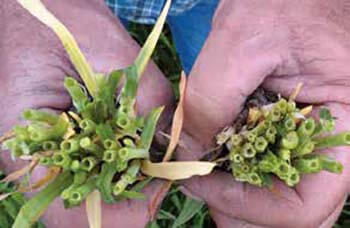Power up your wheat standability with Palisade
Mar 16, 2020

Over the past decade or so, plant growth regulators have been introduced into commercial wheat production throughout winter wheat growing areas, including the South. Palisade from Syngenta is the most popular of these products and by far most widely used in our trade area.
With the ideal application window for this product quickly approaching, now’s the time to review some of the basics of how this product works, what benefits it may offer, and specific scenarios where using Palisade is most likely to offer a good return on investment.
HOW PALISADE WORKS
Plant growth regulators, in general, work in various ways. Specifically, Palisade is a gibberellic acid inhibitor. Gibberellic acid initiates cell elongation in plants. By interfering with this process, the active ingredient in Palisade effectively shortens the internodes (or space between the joints) and strengthens stems.
BENEFITS IT OFFERS
In a crop where standability is absolutely crucial, plants that are shorter (around 2-4 inches depending on variety, plant population, and growing conditions) and stronger have a lower risk of lodging.
Another benefit that isn’t as commonly discussed is the ease of planting double crop soybeans into standing stalks as opposed to a mat of wheat stubble that disc openers have to cut through.
RETURN ON INVESTMENT
High plant densities (35 to 40 plants per square foot) and high rates of nitrogen (greater than 110 pounds per acre) are known to produce high-yielding wheat on strong ground with good fertility. However, add a planting date prior to Oct. 15 to those two factors, and you have a stand that falls into the high-risk category for lodging.
That’s when Palisade will likely provide a good return on investment. In fact, several progressive growers shooting for yields of 100-plus bushels per acre make increasing both seeding rates and total applied nitrogen standard practice and use Palisade to help ensure standability.
Palisade is labeled for use from early onset of stem elongation (or jointing) through second joint (or prior to flag leaf emergence) with the earlier stages of that window optimal to achieve desired results. That means the ideal application window for Palisade is quickly approaching.
If you are interested in discussing your specific crop situation and how Palisade might fit into your management scheme, contact your local Co-op agronomist.
With the ideal application window for this product quickly approaching, now’s the time to review some of the basics of how this product works, what benefits it may offer, and specific scenarios where using Palisade is most likely to offer a good return on investment.
HOW PALISADE WORKS
Plant growth regulators, in general, work in various ways. Specifically, Palisade is a gibberellic acid inhibitor. Gibberellic acid initiates cell elongation in plants. By interfering with this process, the active ingredient in Palisade effectively shortens the internodes (or space between the joints) and strengthens stems.
BENEFITS IT OFFERS
In a crop where standability is absolutely crucial, plants that are shorter (around 2-4 inches depending on variety, plant population, and growing conditions) and stronger have a lower risk of lodging.
Another benefit that isn’t as commonly discussed is the ease of planting double crop soybeans into standing stalks as opposed to a mat of wheat stubble that disc openers have to cut through.
RETURN ON INVESTMENT
High plant densities (35 to 40 plants per square foot) and high rates of nitrogen (greater than 110 pounds per acre) are known to produce high-yielding wheat on strong ground with good fertility. However, add a planting date prior to Oct. 15 to those two factors, and you have a stand that falls into the high-risk category for lodging.
That’s when Palisade will likely provide a good return on investment. In fact, several progressive growers shooting for yields of 100-plus bushels per acre make increasing both seeding rates and total applied nitrogen standard practice and use Palisade to help ensure standability.
Palisade is labeled for use from early onset of stem elongation (or jointing) through second joint (or prior to flag leaf emergence) with the earlier stages of that window optimal to achieve desired results. That means the ideal application window for Palisade is quickly approaching.
If you are interested in discussing your specific crop situation and how Palisade might fit into your management scheme, contact your local Co-op agronomist.